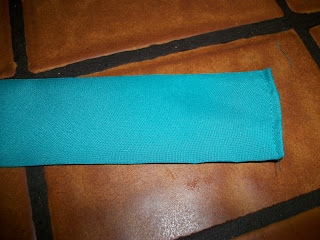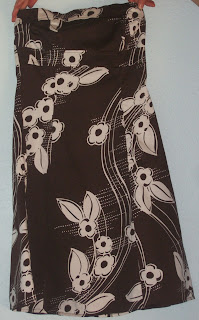How many times have you gone shopping and found a dress that fit perfectly and was really cute, but there were just a few little things that kept it from working for you? Sometimes those 'few little things' are a pain to fix and so I put the dress, or whatever piece of clothing I'm looking at, right back down, but more often than not it's pretty easy to fix them. So, here is one of my dresses - it was long enough (which is often half the battle), it fit, wasn't low cut and it was pretty; however, it was very sleeveless - the straps even curved in - and the back was waaaaayyyyy too low.
So, in order to fix them I needed some fabric, but a different color would have looked weird - at least in my opinion - and the color was very difficult, might as well have been impossible, to match; however, the entire dress was lined - and the lining was the same exact color as the dress. It was a bit different in texture, but not enough that anyone would notice. So, I cut out the skirt lining because honestly, why would you line a skirt that isn't see-through? And so, now I had way more than enough fabric for my few alterations :)
So, I decided to tackle the sleeveless thing first - I didn't want a regular go-all-the-way-around-the-arm sleeve, just a simple cap sleeve. The pattern piece for such a things looks about like the pieces I have cut out below - the thickness is naturally determined by how long of a sleeve you want. So, I cut my sleeves out of the skirt lining...
Hemmed the bottom of the sleeves, and pinned it to the top half of the arm hole. In order to make it even, you find the middle of the sleeve and pin it to the shoulder seam on the dress and just pin down the sides.
Then you sew the two together, kind of tapering the beginning and end of the seam so that the sleeve and the armhole run together smoothly.
Now for the back of the dress. I could have just put a straight piece of fabric across the back, but that would have been rather boring, so I decided to do kind of a crossover thing on the back. What I did was take a really wide piece of fabric, folded it in half and cut it into two pieces. Then I tried the dress on and pinned the two pieces so that they fit me and were as high as I wanted. Once I pinned and measured them, I cut the pieces of fabric to the right size and finished the edges. Then I hand-sewed the tops of the pieces to lining of the dress, but not all the way down, so you can still get the dress on :)
However, the bottom parts need to be held down also, so I hand-sewed hook & eyes to the corners of the inserts and the lining of the dress, so that the pieces will stay down, but can be taken up.
So, now I had a dress without 'just a few little things' :)


















































